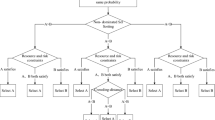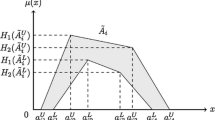Abstract
When it comes to business operation, the institutions have to choose some appropriate projects from numerous projects to invest. To this end, they should consider to establish a project portfolio to make decisions. When building such a portfolio, the project selection and the staff assignment are the most essential parts, which greatly affect the profit of project portfolios. As for the project selection, market returns tend to be asymmetric and investors are often concerned about the skewness risk which is ignored by the traditional project portfolio. Meanwhile, as for the staff assignment, the institutional investors aim at achieving the highest returns by adopting a proper assignment of project managers. In addition, since the exact possibility distributions of uncertain parameters in practical project portfolio problems are often unavailable, we adopt variable parametric credibility measure to characterize uncertain model parameters. In view of these problems, this article proposes a project portfolio model with skewness risk constraints and a project portfolio model with staffing based on credibility measure theory and fuzzy theory in uncertain circumstances. Our two models are associated with risk-free assets so that the remaining funds can be utilized effectively. Finally, we use genetic algorithms to solve our proposed models and present some numerical examples to demonstrate the effectiveness of the proposed models.

Similar content being viewed by others
References
Markowitz, H.: Portfolio selection. J. Finance 7(1), 77–91 (1952)
Markowitz, H.: Portfolio Selection: Efficient Diversification of Investments. Wiley, New York (1959)
Mao, J.: Models of capital budgeting, E-V vs. E-S. J. Financ. Quant. Anal. 4(5), 557–675 (1970)
Yan, W., Li, S.R.: A class of multi-period semi-variance portfolio selection with a four-factor futures price model. Appl. Math. Comput. 29(1–2), 19–34 (2009)
Wu, H.L., Zeng, Y., Yao, H.X.: Multi-period Markowitz’s mean–variance portfolio selection with state–dependent exit probability. Econ. Model. 36, 69–78 (2014)
Ruiz-Torrubiano, R., Suárez, A.: A memetic algorithm for cardinality-constrained portfolio optimization with transaction costs. Appl. Soft Comput. 36, 125–142 (2015)
Santhanam, R., Kyparisis, J.: A multiple criteria decision model for information system project selection. Comput. Oper. Res. 22(8), 807–818 (1995)
Medaglia, A.L., Graves, S.B., Ringuest, L.J.: A multiobjective evolutionary approach for linearly constrained project selection under uncertainty. Eur. J. Oper. Res. 179(3), 869–894 (2007)
Huang, X.X.: Mean variance model for fuzzy capital budgeting. Comput. Ind. Eng. 55(1), 34–47 (2008)
Wang, C.S., Chen, W.: A fuzzy model for R&D project portfolio selection. In: 2011 International Conference on Information Management, Innovation Management and Industrial Engineering (ICIII 2011), Shenzhen, China (2011)
Cho, W., Shaw, M.J.: Portfolio selection model for enhancing information technology synergy. IEEE Trans. Eng. Manag. 60(4), 739–749 (2013)
Arditti, F.D., Levy, H.: Portfolio efficiency analysis in three moments: the multi-period case. J. Finance 30(3), 797–809 (1975)
Athayde, G.M., Flores, R.G.: Finding a maximum skewness portfolio: a general solution to three-moments portfolio choice. J. Econ. Dyn. Control 28(7), 1335–1352 (2004)
Brunnermeier, M.K., Gollier, C., Parker, J.A.: Optimal beliefs, asset prices, and the preference for skewed returns. Am. Econ. Rev. 97(2), 159–165 (2007)
Barberis, N., Huang, M.: Stocks as lotteries: the implications of probability weighting for security prices. Am. Econ. Rev. 98(5), 2066–2100 (2008)
Chang, B.Y., Christoffersen, P., Jacobs, K.: Market skewness risk and the cross section of stock returns. J. Finance Econ. 107(1), 46–68 (2013)
Kraus, A., Litzenberger, R.H.: Skewness preference and the valuation of risk assets. J. Finance 31(4), 1085–1100 (1976)
Hawawini, G.A.: An analytical examination of the intervaling effect on skewness and other moments. J. Financ. Quant. Anal. XV(5), 1121–1128 (1980)
Cui, Y.Y., Wang, J.Q., Zhuang, H.G.: Portfolio with skewness considering parameter uncertainty. Syst. Eng. Theory Pract. 31(9), 1628–1634 (2011)
Kima, W.C., Fabozzi, F.J., Cheridito, P., Fox, C.: Controlling portfolio skewness and kurtosis without directly optimizing third and fourth moments. Econ. Lett. 122(2), 154–158 (2014)
Amaya, D., Christoffersen, P., Jacobs, K., Vasquez, A.: Does realized skewness predict the cross-section of equity returns? J. Financ. Econ. 118(1), 135–167 (2015)
Li, X., Guo, S., Yu, L.: Skewness of fuzzy numbers and its applications in portfolio selection. IEEE Trans. Fuzzy Syst. 23(6), 2135–2143 (2015)
Zadeh, L.A.: Fuzzy sets as a basis for a theory of possibility. Fuzzy Sets Syst. 1, 3–28 (1978)
Chen, I.F., Tsaur, R.C.: Fuzzy portfolio selection using a weighted function of possibilistic mean and variance in business cycles. Int. J. Fuzzy Syst. 18(2), 151–159 (2016)
Xu, W.J., Deng, X., Li, J.: A new fuzzy portfolio model based on background risk using MCFOA. Int. J. Fuzzy Syst. 17(2), 246–255 (2015)
Zhou, X.Q., Li, Q.G.: Generalized hesitant fuzzy prioritized einstein aggregation operators and their application in group decision making. Int. J. Fuzzy Syst. 16(3), 303–316 (2014)
Sari, I.U., Kahraman, C.: Interval type-2 fuzzy capital budgeting. Int. J. Fuzzy Syst. 17(4), 635–646 (2015)
Kou, S.C., Chen, C.C., Li, S.T.: Evolutionary fuzzy relational modeling for fuzzy time series forecasting. Int. J. Fuzzy Syst. 17(3), 444–456 (2015)
Chen, Z.S., Chin, K.S., Li, Y.L.: A framework for triangular fuzzy random multiple-criteria decision making. Int. J. Fuzzy Syst. 18(2), 227–247 (2016)
Carlsson, C., Fullér, R., Majlender, P.: Project selection with fuzzy real options. In: Proceedings of the Second International Symposium of Hungarian Researchers on Computational Intelligence, vol. 12, pp. 81–88 (2001)
Huang, X.X.: Optimal project selection with random fuzzy parameters. Int. J. Prod. Econ. 106(2), 513–522 (2007)
Carlsson, C., Fullér, R., Heikkilä, M., Majlender, P.: A fuzzy approach to R&D project portfolio selection. Int. J. Approx. Reason. 44(2), 93–105 (2007)
Bhattacharyya, R., Kumar, P., Kar, S.: Fuzzy R&D portfolio selection of interdependent projects. Comput. Math. Appl. 62(10), 3857–3870 (2011)
Ebrahimnejad, S., Mousavi, S.M., Tavakkoli-Moghaddam, R., Hashemi, H., Vahdani, B.: A novel two-phase group decision making approach for construction project selection in a fuzzy environment. Appl. Math. Model. 36(9), 4197–4217 (2012)
Hassanzadeh, F., Collan, M., Modarres, M.: A practical approach to R&D portfolio selection using the fuzzy pay–off method. IEEE Trans. Fuzzy Syst. 20(4), 615–622 (2012)
Collan, M., Luukka, P.: Evaluating R&D projects as investments by using an overall ranking from four new fuzzy similarity measure-based TOPSIS variants. IEEE Trans. Fuzzy Syst. 22(3), 505–515 (2014)
Liao, H.C., Xu, Z.S., Zeng, X.J.: Novel correlation coefficients between hesitant fuzzy sets and their application in decision making. Knowl. Based Syst. 82, 115–127 (2015)
Liu, W.S., Liao, H.C.: A bibliometric analysis of fuzzy decision research during 1970–2015. Int. J. Fuzzy Syst. (2016). doi:10.1007/s40815-016-0272-z
Liu, B.: Uncertainty Theory: An Introduction to Its Axiomatic Foundations. Springer, Berlin (2004)
Zhang, W.G., Mei, Q., Lu, Q., Xiao, W.L.: Evaluating methods of investment project and optimizing models of portfolio selection in fuzzy uncertainty. Comput. Ind. Eng. 61(3), 721–728 (2011)
Zhang, X.L., Zhang, W.G., Cai, R.C.: Portfolio adjusting optimization under credibility measure. J. Comput. Appl. Math. 234(5), 1458–1465 (2010)
Huang, X.X.: An entropy method for diversified fuzzy portfolio selection. Int. J. Fuzzy Syst. 14(1), 160–165 (2012)
Vercher, E., Bermudez, J.D.: Portfolio optimization using a credibility mean-absolute semi-deviation model. Expert Syst. Appl. 42(20), 7121–7131 (2015)
Liu, Y., Liu, Y.K.: Distributionally robust fuzzy project portfolio optimization problem with interactive returns. Appl. Soft. Comput. (In Press) (2016)
Liu, B.: Uncertainty Theory, 2nd edn, pp. 81–156. Springer, Berlin (2007)
Huang, X.X.: Mean–semivariance models for fuzzy portfolio selection. J. Comput. Appl. Math. 217(1), 1–8 (2008)
Li, X., Qin, Z.F., Kar, S.: Mean–variance–skewness model for portfolio selection with fuzzy returns. Eur. J. Oper. Res. 202(1), 239–247 (2010)
Zhang, W.G.: Investment project risk assessment and the best selection method. Quant. Technol. Econ. Res. 5, 51–54 (1998)
Carlsson, C., Fullér, R.: Capital budgeting problems with fuzzy cash flows. Mathw. Soft Comput. 6(1), 81–89 (1999)
Sharpe, W.F.: Capital asset prices: a theory of market equilibrium under conditions of risk. J. Finance 19(3), 425–442 (1964)
Huang, C.F., Chang, B.R., Cheng, D.W., Chang, C.H.: Feature selection and parameter optimization of a fuzzy-based stock selection model using genetic algorithms. Int. J. Fuzzy Syst. 14(1), 65–75 (2012)
Kelly, G.A.: The Psychology of Personal Constructs. Routledge Chapman Hall, New York (1992)
McClelland, D.C.: Identifying competencies with behavioral-event in view. Psychol. Sci. 9(5), 331–339 (1998)
Acknowledgements
The authors would like to acknowledge the support of the National Natural Science Foundation of China (Nos. 71471065, 71171086), the Program for New Century Excellent Talents in University (No. NCET–10–0401), and the Guangzhou Financial Services Innovation and Risk Management Research Base.
Author information
Authors and Affiliations
Corresponding author
Rights and permissions
About this article
Cite this article
Xu, W., Liu, G., Li, H. et al. A Study on Project Portfolio Models with Skewness Risk and Staffing. Int. J. Fuzzy Syst. 19, 2033–2047 (2017). https://doi.org/10.1007/s40815-017-0295-0
Received:
Revised:
Accepted:
Published:
Issue Date:
DOI: https://doi.org/10.1007/s40815-017-0295-0




